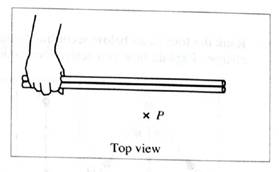
Imagine that two charged rods are held together as shown and a charged pith ball is placed at point P.
Predict whether the rod farther from point P would exert an electric force on the pith ball. Explain.

Check your prediction by placing a charged pith bail al point P near two charged rods and then slowly moving one rod away from the other. Describe your observations and discuss with your partners whether your results from this experiment support your prediction.
Learn your wayIncludes step-by-step video

Chapter 5 Solutions
Tutorials in Introductory Physics
Additional Science Textbook Solutions
Physics: Principles with Applications
The Cosmic Perspective (8th Edition)
University Physics Volume 2
University Physics with Modern Physics (14th Edition)
Physics (5th Edition)
Lecture- Tutorials for Introductory Astronomy
- Consider (3) point charges that are located on a circular arc of radius r = 3.60 cm as shown in the figure. Show your work and use significant figures in the final answer. a. Find the electric field at point P.[ Answer: 22,200 N/C ]arrow_forwardCompute for the following. Round your answers into to 2 significant figures. 1. What is the charge of an object that has 3,000,000 excess electrons? 2. What is the charge of an object that has 5,000,000 electron deficits? 3. How many excess electrons are there in an object with a charge if -3.6 ×10^-17 C?arrow_forwardSolve the problem and draw and label a vector diagram in the given problem. Part 1. Two charges A (+30 µC) and B (–40 µC) are 60 cm apart. What is the net field strength at a point midway between them? Part 2. What is the net electric field intensity at a point 20 cm to the left of charge A in No.1? Assume that the point and the charges are collinear.arrow_forward
- What is the approximate electrostatic force between two protons separated by a distance of 1.0 x 10^-5 meter? Is it attractiv4 or repulsive? Show your solution.arrow_forwardCalculate the net vertical force acting on the charge at the lower left corner of the rectangle, in newtons. Part (f) Calculate the magnitude of the net force on the charge located at the lower left corner of the rectangle, in newtons Part (g) Calculate the angle, in degrees counterclockwise with respect to the positive -axis, of the net force acting on the charge at the lower left cornethe rectangle. Enter your answer as an angle between O and -180°arrow_forwardA point charge of -15 nC (~15 x 102 C) is located at <4, 3, -2>m. (a) What is the (vector) electric field contributed by this charge at location <6, 2, 3> m? You need to show all your work carefully in order to get credit.arrow_forward
- Consider a very thin semi-circle of charge as shown, with radius of R. Explain with words and equations how you would derive the electric field vector measured at the center of this line of charge curved into a semi-circle with radius R (Measure E at the origin).arrow_forwardThe angle between the two short sides is 90°. The two short sides of the triangle have length a. Investigate the net force on the charge (q) in the lower right corner due to the other two charges (q, -q). As needed, assume a right-handed coordinate system shown below: (A) What is the magnitude of the net force on the charge in the lower right corner due to the other charges? Use symbols for the answer. (B) Make a sketch of the net force vector on the x-y axes below with the tail of the arrow at the origin. Label the angle with the x-axis. What quadrant does the vector lie in? Your picture should indicate the correct quadrant.arrow_forwardAn object has a charged of +3.4 uC. How many electrons would it need to gain to achieve a charge of +1.0 uC? Show your work. What is the magnitude and direction (- or +) of the net electric field at the origin? Include the sign in your answer to indicate the -x or +x direction.arrow_forward
- What is the strength in (N/C) of the electric field at the position indicated by the dot in the diagram above? The charge on the points labeled A and A* is +1.57 nC. The x distance is 8.99 cm. What is the angle (in degrees) of the electric field at the position indicated by the dot in the diagram above? Take the point to be the origin and the angle is measured counterclockwise from the horizontal axis away from A.arrow_forwardThree point charges are arranged as shown in the figure below. (a) Find the electric field vector (magnitude and direction) the 6.00 nC and -3.00 nC charges create at the origin. (Ignore the 5.00 C charge for now!). (b) Find the force vector (magnitude and direction) on the 5.00 nC charge when it is placed at the orgin. (Hint: use your answer from part (a) to make this easier.)arrow_forwardA charge Q1 = +3 μC is located at (-5 cm, 0) while charge Q2 = -4 μC is located at (0, +5 cm). These are the two white charges in the diagram at right. a) What is the electric field at the origin (0, 0) due to these two charges? b) If a third charge of 5 μC (the gray charge) is placed at the point (-4 cm, 3 cm), what will now be the electric field at the origin?arrow_forward

 Glencoe Physics: Principles and Problems, Student...PhysicsISBN:9780078807213Author:Paul W. ZitzewitzPublisher:Glencoe/McGraw-Hill
Glencoe Physics: Principles and Problems, Student...PhysicsISBN:9780078807213Author:Paul W. ZitzewitzPublisher:Glencoe/McGraw-Hill

